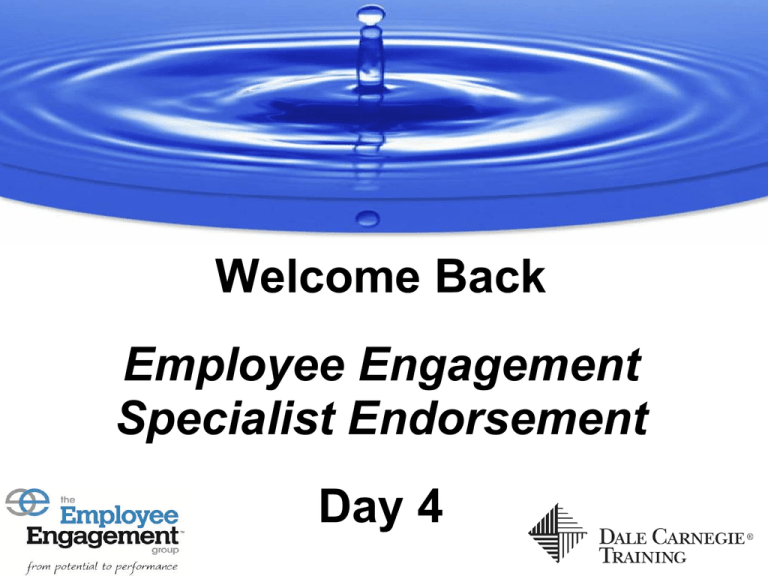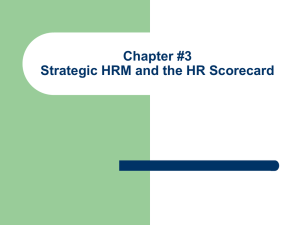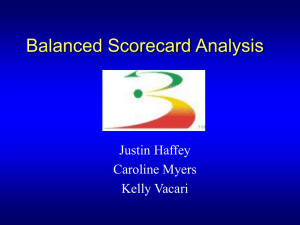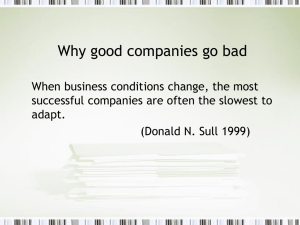
Welcome Back
Employee Engagement
Specialist Endorsement
Day 4
Action Plan for Day 4
– Complete the Motivation Team assessment on
at least 5 people. For each person identify the
primary and at least one secondary motivator.
– Have those 5 people complete their own
assessment and compare your answers to
theirs
• Did you identify their motivators correctly?
• Did it help you to determine how to provide additional motivation?
– Use the HIT process with a small group to help
determine the best solution for a problem
Agenda
Time
Topic
7:30 – 8:00
Networking and Breakfast
8:00 – 8:10
Welcome and announcements
8:10 – 8:40
Discussion and review of assignments
8:40 – 9:45
Designing and Implementing a Balanced Scorecard
9:45 – 10:00
Break
10:00 – 12:00
Effective Reward and Compensation Programs
12:00 – 12:30
Lunch
12:30 – 2:15
Recruiting and Hiring Engaged Employees
2:15 – 2:30
Break
2:30 – 4:00
Recruiting and Hiring Engaged Employees
4:00 – 4:30
Review of day and assignments
Developing a Balanced
Scorecard
What is a Balanced Scorecard?
Page 4
A Balanced Scorecard:
– Is a concept and tools by Robert Kaplan and David Norton –
debuted in Harvard Business Review in 1992
"The balanced scorecard retains traditional financial measures. But financial
measures tell the story of past events…. These financial measures are
inadequate, however, for guiding and evaluating the journey that information
age companies must make to create future value through investment in
customers, suppliers, employees, processes, technology, and innovation."
– Allows managers to view critical operational factors and their
inter-relationships with current and future performance in
mind
– Provides focus on organizational vision and long-term
success
What is a Balanced Scorecard?
Adapted from Robert S. Kaplan and
David P. Norton, “Using the
Balanced Scorecard as a Strategic
Management System,” Harvard
Business Review (January-February
1996): 76.
What is a Balanced Scorecard?
“Balance” comes from the ‘cause
and effect’ nature of the tool
Adapted from Robert S. Kaplan and
David P. Norton, “Using the
Balanced Scorecard as a Strategic
Management System,” Harvard
Business Review (January-February
1996): 76.
Why Implement a Balanced Scorecard?
– Link’s Company’s Vision, Strategy, and Results
– Align organization strategy with the work people do on a
day-to-day basis – Line of Sight
– Prioritize projects / initiatives
Balanced Scorecard Institute
Case Study - Why to Implement a Balanced Scorecard?
Employee survey results showed:
– The Company does not have:
• easily accessible data
• communicate monthly progress to all
• a culture of “stretch” goals
– Employees not aware of:
•
•
•
•
•
Company’s performance against Business Plan
their own department or business’ performance to Plan
their own performance against goals and objectives
definition of “average” performance
the metrics of “high performers”
Adapted from ENSR
balanced scorecard discussion
Exercise: What’s Your Reason?
Discuss why your company is interested in creating and
using a balanced scorecard.
The Evolution of a Balanced Scorecard
Final
tweaks to
system
Mgmt. review
and approval
2
3
4
5
6
7
8
9
2/10
8/10
Idea for aligned
metrics
Team
consensus
on metrics
Mgmt. accepts
BSC
10
11
12
1
2
3
4
4/10
6-month IT build out
Roll out to
company
Multiple iterations for
readability and printability
“Balanced scorecard structure may take 5-6 months to develop, with total
completion in about 1 year”
Balanced Scorecard Basics on Implementation, Valerie Pike
The Development Process
– Get enthusiastic support and commitment from top
management
– Carefully select the design team
• Cross-representation
• Get your IT support on board early
– Determine what the true drivers of performance are
• Enlightening process
• Defines the “heart” of the organization
• Focus in on ‘cause and effect’ relationships
– Determining how to measure (would you like that in
pounds, inches, pieces or adjectives?)
– What are the design and functionality criteria?
– Create consistent definitions
Exercise: What are you measuring?
– What are you currently measuring at your organization?
– Should you be measuring other metrics? What are they?
© The Employee Engagement Group
All Rights Reserved
Balanced Scorecard Data Breakdown Example
Balanced Scorecard Overall Data Example
© The Employee Engagement Group
All Rights Reserved
Balanced Scorecard Graphic Display Example #1
© The Employee Engagement Group
All Rights Reserved
Balanced Scorecard Graphic Display Example #2
Balanced Scorecard Example (Individual)
Scorecard for: Bob Johnson
Balanced Scorecard Definitions Example
© The Employee Engagement Group
All Rights Reserved
Balanced Scorecard Example
Balanced Scorecard Example
© The Employee Engagement Group
All Rights Reserved
Balanced Scorecard Example
© The Employee Engagement Group
All Rights Reserved
Balanced Scorecard Example
© The Employee Engagement Group
All Rights Reserved
Exercise: What does your scorecard look like??
In your groups, design your scorecard:
– What does it look like on the screen?
– What graphics are used?
– How is it made to be user friendly?
Report back and begin to determine what your scorecard
looks like
To Buy or Build
Buying
– Pros
• Off the shelf ready
• Professional look and feel
• May include design
support
– Cons
• Maintenance comes
from outside
• Difficult to customize
• Programming changes can be
expensive
• Needs tied to costs
Building
– Pros
• Design and customize to
your specific needs
• Tie easily to your data
• Changes done quickly at minim
cost
– Cons
• Significant investment of IT
resource(s)
• May not have the ‘professional’
look and feel
• Longer development time
The Roll Out
– Communication Plan (consider linking with our
Communication Protocol)
– Hold line managers accountable
– Avoid over-engineering
– Include training sessions
The Maintenance – Yes, There are Costs
– On-going investment will be different in
every
organization
– In case study company’s case:
• Manual HR and H&S input each month (sometimes a bottleneck)
• Delays from chasing and “normalizing” international data
• Data still requires QA by knowledgeable person to ground-truth
– Constant communication and integration with internal
processes
– Ongoing IT support and maintenance to keep it fresh
But ideally, the benefits greatly outweigh the costs
Keeping it Vibrant
– Reference in CEO communication
(part of your Communication Protocol)
– Use in quarterly operations review
– Prominent place on intranet
– Point employees there to answer their questions
– Communicate positive trends visible on scorecard (and
negative trends as an “early warning system”)
Page 8 - 22
Recommendations
– Before anything else, seek management
buy-in!
– Make sure someone owns it
– Keep it simple and focused
• One screen / one page / graphics
– Make it relevant and understandable to all
employees
– Treat it as a learning tool – not a control tool!
“Organizations that have not involved employees have not
achieved desired results”
- Valerie Pike
Effective Reward and
Compensation Programs
Exercise
– Team up with someone
who you have never
teamed up with before
– Describe an example
when you were
recognized professionally
that had great impact with
you, even today.
Total Rewards
– Compensation (including Bonuses, and Incentive
Plans)
– Benefits
– Work- Life
– Recognition
– Training and Development
Reward vs. Recognition
Difference between Reward and Recognition
Reward
– Significant
• Year end or quarterly
bonus
• Promotion
– Includes some sort of
monetary increase
– Usually recognizes long
term
Page 9
Difference between Reward and Recognition
Page 9
Recognition
• Reserved to highlight an
event, episode, and/or
going above and beyond
• Often includes something
of value (money, time,
etc.)
• ‘Thank you’ is recognition
but recognizes a job well
done (not necessarily
above and beyond)
Compensation
(including Bonuses)
Case Study
Team up in groups of 3 – 4 and answer
these questions about the case study
1. Come up with a plan to divide both
your salary pool and bonus pool.
How do you base your decisions?
2. What additional decisions would you
make as department manager
Page 10
Compensation
–
–
–
–
Base Pay
Variable Pay(ie commissions, tips)
Short term incentives (bonus plans)
Long term incentives (stock,
Compensation
Golden Rule
Fairness rules!
it’s about fair pay,
not high pay
Fairness
rules
(it’s about
fair pay,
not high
pay)
Children and monkeys
recognize when things
are unfair
Your employees recognize
unfairness as well
How do you think they respond? What
‘cucumbers’ are they throwing?
Today’s Business Environment
– Pay increases have been small
– Promotions have been few (slow growth and
low turnover is perfect storm for status quo)
– Hiring is just now picking up (we’ve been
doing more with less)
– Bonuses have returned but smaller
– Layoffs have slowed
– Survivor anxiety/burnout
Some Compensation Principles
– Compensation communicates
– Compensation is emotional
– Compensation should drive the
behavior you’re looking to drive
– Compensation should reward achievement
Compensation 10 Commandments
Complete the evaluation assessment
Page 11
Compensation 10 Commandments
1. Communication must be frequent and
transparent
2. You must PAY for performance
3. You need a balance of qualitative and
quantitative metrics
4. The peanut butter approach must be avoided
5. Avoid greasing the squeaky wheel
6. Do not over pay base compensation
7. Hot markets and sectors should be rewarded with
variable pay whenever possible
8. Do not confuse Rewards and Recognition
9. Always emphasize achievement
10. Must always be fair
Base Pay
Base Pay
– Year end ‘merit’ pool (change it to salary
adjustment program)
– Have been averaging 2 - 4% for many
years
– Very difficult to ‘pay for performance’ with
merit pools being so small the past 20
years
– Promotional budgets – can be
.5 - 2%
Cash Bonuses
From Your Pre-work
– What percentage of your population is eligible for
bonuses?
– What percentage of the bonus is based on
qualitative results?
• What are examples of your qualitative measurements?
– What percentage of the bonus is based on
quantitative results?
• What are examples of your quantitative measurements?
Bonus Programs
Page 12
– Profit Sharing
– Gain Sharing bonus programs are most common in
manufacturing and are designed to reward
productivity and improved product quality
– Spot Bonus Awards reward employees on the spot
for achievements that deserve special recognition.
Spot bonus awards are typically $50 and up
– Sign-On Bonuses are commonly used for new
employees
– Mission, Task or Milestone Bonus are given as a
reward for special achievements and are usually offered
sparingly.
Bonus Programs (continued)
Page 12
– Referral Bonuses are paid to employees
who refer friends
– Retention Bonuses are given to employees
in circumstances, such as a merger or
acquisition, to provide continuity through a
certain time period when there is potential
uncertainty about an employee’s continued
employment at the company.
– Holiday Bonuses
– Sales Commissions
Incentive Plans
“The more
GENEROUS and
FORMULATIC you
make your incentive
plans, the greater
the probability your
employees will
CHEAT!!”
Dr. Dean Spitzer,
author of
"Transforming Performance Measurement"
Incentive Plans
–
–
–
–
–
Eligibility can vary – usually mid to senior level
Can be designed as formulaic or discretionary
Best plans incentivize high performance
Best plans differentiate high and low performance
Best plans also have both quantitative and qualitative
metrics
– Best senior leadership plans link metrics with company
wide results (to reduce silo behavior)
– Best mid level plans tie payout window (timing) as close to
behavior as possible
Quantitative Measurements (THE WHAT)
Health & Safety
OSHA recordable & lost time case
rates
Employee Engagement (for line
Managers)
Turnover of Staff
EDP % Completion (Managers)
Employee Engagement Survey
Results
% of Recognition Budget spent
% of Learning (% of payroll)
Cost Management
Working Capital Management
Non-Labor Cost Management
Client Satisfaction and Quality
Net promoter score
% Repeat business
Overruns and write-offs
Quantitative Measurements (THE WHAT)
Profitability
Budget Management
Individual Profit Contribution
Utilization
Days Sales Outstanding
Revenue Growth
Opportunity Backlog
Proposal Backlog
Bookings
Account Management
Lead Generation
Gross Sales
Net Sales
Qualitative Measurements (THE HOW)
Teamwork
Health & Safety Awareness
Self Starter
Solution Driven
Support of Company's Strategic Initiatives
Attitude
Efficiency
Cost Considerations
Work Life Balance
Quality
Client Service
Innovative
Bonus / Pay Matrix
High
X%
Performer
2X%
Star
Performan
ce
0%
Transition
Investment
X%
Low
Low
Potential
High
Exercise: Bonus / Pay Matrix
Page 13
• Think about 10 people in your organization.
• If you were going to assign bonuses to those 10
people, in what quadrant would you put them?
The Law of Unintended Consequences
&
Long Term Incentives Programs
Work / Life Blending
Work Life Blending
–
–
–
–
–
–
–
Flexible Work Hours
Telecommuting
Emergence of unlimited vacation time
Job sharing
Sabbaticals
Part time benefit packages
Community Involvement
Page 14
Recognition Programs
Difference between Reward and Recognition
Page 9 - 2
Recognition
• Reserved to highlight an
event, episode, and/or
going above and beyond
• Often includes something
of value (money, time,
etc.)
• ‘Thank you’ is recognition
but recognizes a job well
done (not necessarily
above and beyond)
Your Pre-work…
– What are some examples of ongoing
recognition programs you have in your
organization?
• What problem are you attempting to solve?
• What specifically are you recognizing?
– What other types of recognition
programs have you seen?
Recognition challenges
(SHRM G2012 Global Survey)
Recognition via Gamification
– Definition:
Gamification is the use of game elements in any context
that is non-game related, usually by providing rewards
and by fostering user interaction with the learning
material.
•
•
•
•
The form of rewards can vary, but the more common ones include:
Points
Badges
Levels
– Leaderboards
– Challenges
By 2014, 70% of global
businesses will be
using some form of
gamification
Gartner Research
Nissan created a way to engage customers to provide info about their Nissan
Leaf (100% electric car)
• Compare performance of your vehicle
• Communicate with your car through your cell phone
• Earn points for performance, maintenance, and entering information
Recyclebank rewards users for doing everyday things that are good for the
environment.
• Earn points by pledging to follow green living techniques
• Trade points for discounts from vendors
• Compare your rank against others (leaderboard)
Gamification as Recognition
What examples of gamification can you think of or have you
used?
Evaluating your Recognition Programs
Has value to who it is
given to on all
levels
Everyone
receives in a
fair and ongoing
process
All employees have
the opportunity
to achieve
Related
directly to a
known goal or
specific outcome
Evaluate your Rewards and Recognition
Using the reward and recognition form, evaluate
two of your programs to be sure it is:
• Available to everyone
• Tied to a specific outcome
• Delivered consistently
• Valued by the employees
Page 16
Exercise – What is the best example of
recognition?
In your assigned groups, come up
with a list of recognition program
examples that you have seen.
Then, vote and present back one
recognition example that is the best
of your list
Recognition Ideas and Best Practices
• Schedule reminders
• Have ‘valuable’ items on hand to
hand out
• Hats, shirts
• Movie tickets
• Gift cards
• Establish a formal award given to an employee
as a culmination of the year (but don’t overdo)
• Let other recognize – it’s not just you that can
recognize
• Write a note!
Engagement
Action Plan
Page 32
Action Plan for Day 5
– Evaluate your organization on it’s work – life
blending processes
– Evaluate several recognition processes being
sure they are
•
•
•
•
Available to everyone
Tied to an outcome
Delivered consistently
Valued by employees
Lunch
Recruiting and Hiring
Engaged Employees
Selecting the Wrong Person Can Be Terrifying!
“I don’t worry about hiring a great
employee and having him leave in
three months, I worry about hiring
a bad employee and having him stay
for three years!”
-- Anonymous
What’s your hiring horror story?
In your groups:
−Share a hiring horror story
−Select the best story to share
with the rest of the workshop.
−When called upon, share the
story your group selected
© The Employee Engagement Group
All Rights Reserved
Recruiting Partnership
HR
High
Quality
Candidates
First line
leaders
Suggested Roles and Responsibilities
Role/Responsibility
Conduct analysis (consider your succession plan and HIPOs)
Create a job requisition
Share opportunities with other offices, areas, and company
Post all positions internally
Encourage employee referrals
Initiate social media recruiting
Ongoing proactive structured recruiting
Manage on-line postings (e.g., Monster, Craig’s List, etc)
Manage recruiting firms (e.g., headhunters)
Page 20
HR
Mgr
Recruiting Modes
Page 21
Crisis
Recruiting
When you need people
‘yesterday’
When should you be recruiting new employees?
ALWAYS!
Proactive Recruiting
Recruiting even when you
don’t have a position to fill
Hire Hard, Live Easy, Hire Easy, Live Hard
Bob Kelleher
Right Candidate “Types”
Active
Needs a job
Aggressively looking
Passive
No desire for
new job
Don’t call
SemiActive
Wants a better job
Looking
sometimes
SemiPassive
Wants a better job
Waiting for
your call
Page 21
Skills/Tenure or Accomplishments
Skills/Tenure
Accomplishments
Have 10 years experience
Increased client x account by 15%
in one year
Have good planning skills
Submitted strategic plan in 90 days
and hired 3 people
Good problem solver
Worked with dept. x to eliminate
processing bottleneck
See additional examples in your workbook
Know Your Needs Using the B.E.S.T. Concept
Behavior
How one acts or
reacts to specific
circumstances
Demonstrated
through
performance,
actions, and
conduct
Examples:
• Expressing one
self clearly
• Meeting project
deadlines
• Calm under
pressure
Education
The knowledge one
carries with him/her
Demonstrated
through diplomas
and certificates
Examples:
• Master of Science
in Hydrology
• HazMat Certificate
Skills
The ability to put
knowledge into
action
Demonstrated
through activities
and assignments
Examples:
• Technical writing
• Accurately interprets lab results
• Proficient in Excel
and Access
Page 10 - 3
Traits
Characteristics that
define someone’s
personal nature
Demonstrated
through presentation
and actions
Examples:
• Accountability
• Integrity
• Enthusiasm
• Optimism
• Collaborative
Exercise – Behaviors and Traits
– List the behaviors/traits that you would like to see in
an employee as assigned below:
• Case A – Project Manager
• Case B – Department Manager
• Case C – Sales Manager
– Part 2
• What behaviors/traits do you think are
unique to your industry or company?
How can this exercise help you with selecting
people for open positions?
Developing a B.E.S.T. Profile
Page 23
Define the job in
general terms
Create 5 – 6
accomplishments you
want to see in the first
6 – 12 months
List behaviors/traits
that are essential for
success
Exercise - B.E.S.T Profile
1. Break into groups of two or
three
2. Select a position for which you
are hiring (or could be hiring in the future)
3. Use the B.E.S.T. Profile to prepare to staff for
this position.
•
•
List 6 – 8 performance objectives
Make a list of the behaviors and traits, education,
and skills that you will be looking for
4. Be prepared to discuss your B.E.S.T. Profile
Exercise - Sources for Candidates
− To ensure a thorough search,
use the Recruiting Sources
Planning Guide to stimulate
basic and creative recruiting
venues.
− Work with a partner to select
a real or hypothetical position
to recruit.
− Using the Recruiting Sources
Planning Guide form
document as many specific
sources for candidates as
possible and appropriate
Page 27
Recruiting Your Brand
Knowing Your Brand
Many companies simply don’t know who they are
and therefore can’t hire the types of people who
will be engaged in their culture
In other words,
“You don’t have an Engagement problem,
you have a Selection problem.”
Do you know why people work for your company?
What is your Employer Value Proposition?
Your Employer Value Proposition
What you do
Why you do it
Why do
people
work for you?
Brand Who You Are
What do these
companies have
in common?
Brand Who You Are
Tri-branding
EVP
(Employment
Value
Proposition)
Third Party
Branding
(Customers,
Vendors,
Suppliers)
Product or
Service
Branding
Know Who You Are
The Holy Grail of Branding
Brand
Awarenes
s
Brand
Knowledg
e
Brand
Believers
Brand
Deliverer
s
Exercise – How can others recruit for you?
Employees
Clients
Knowing Your Brand Allows You To Design
The Right Recruitment Message
Employee Referral Programs
Employee Referral Program (ERP)
69% of employers say they have a formal
employee referral program
26% of external hires
are generated from
employee referrals
82% of employers rated employee referrals above all
other sources for generating the best ROI
88% of employers rated employee referrals above all other
sources for generating quality new hires
2010 CareerXRoads Sources of Hire Study
Employee Referral Program (ERP)
Listen to employees
Track successes
Communicate
progress
Generations
Keep it simple
Demonstrate how
Positions available
ID who makes a good
referral
Ongoing
Evaluation
Education
Employee
Involvement
Appropriate
Incentives
Oracle White Paper, Shortest Path to Better Hires 2013
JobVite, Optimizing Your ERP, 2012
Page 28
Encourage social media
Their motivations
Improvements
Overall program
Who’s eligible?
Cash
Donations
Drawings
Hardware (i.e., iPad)
Time off
Employee Referral Program (ERP)
Listen to employees
Track successes
Communicate
progress
Ongoing
Evaluation
Employee
Involvement
Page 28
Encourage social media
Their motivations
Improvements
Overall program
Who’s eligible?
Exercise – How does your ERP meet these best
practices? What do you do well? What could you do
better?
Generations
Keep it simple
Demonstrate how
Positions available
Education
Appropriate
Incentives
Cash
Donations
Drawings
Hardware (i.e., iPad)
Time off
Social Media in Recruiting
Social Media and Recruitment
Staff.com
Recruiting.jobvite.com
Business.time.com
Careerxroads.com
Directemployers.org
Based on 2013 stats
Social Media and Recruitment
Staff.com
Recruiting.jobvite.com
Business.time.com
Careerxroads.com
Directemployers.org
Based on 2013 stats
Social Media and Recruitment
Staff.com
Recruiting.jobvite.com
Business.time.com
Careerxroads.com
Directemployers.org
Based on 2013 stats
Social Media and Recruitment
How to Recruit on Facebook
For Free
– Post on your status you’re looking
for a job
– Encourage your employees to post
(link with your referral program)
– Utilize the Facebook Directory to search for users, pages,
groups and applications
– Create a Facebook Page
– Post on Marketplace
Pay
– Create a Facebook Ad
• Targets specific audience; you pay based on hits
How to Recruit on LinkedIn
For Free:
– Build connections to people you already know
• former co-workers, current clients, local entrepreneurs and even
friends and family.
– Join Groups
• For example, if you are always looking for Geotechnical Engineer,
you can find an affiliated group on LinkedIn
– Use your network activity box (also known as a status box) to
broadcast that you are hiring. "Looking for a Geotechnical Engineer.
If you know someone, maybe even you. Contact me."
– You can find out a lot about a person from their profile before
contacting them for an interview.
– Encourage your employees to post jobs (link with your referral
program)
How to Recruit on LinkedIn
Pay:
– Post jobs you have available for $395 to post a job for 30
days.
– Buy credits and pay less per job posting discounts for 5job and 10-job packages
– Sign up for LinkedIn Talent Finder
Social Media and Recruitment
Top Reasons to Use Twitter in Recruiting
– Allows you to connect with current and
potential employees
– Lets you send important company or industry
messages (with links)
– You can view what others are saying about your
company (both good and bad)
– Communicate job openings and new hires
– Twitter will only grow – the sooner you take advantage of
it’s power, the better you will be able to recruit and brand
How to Recruit on Twitter
For Free
– Tweet Your Job Opening
– Use Hash Tags
#MechanicalEngineer
– Ask your employees to tweet openings (reinforce your
employee referral program as an incentive)
How to Recruit on Twitter
Social Media and Recruitment
– Four billion video views per day
Let’s look at how others have
used YouTube to recruit
Case Study A
Case Study B
#
# 44
18
Social Media and Recruitment
How could you use YouTube for
recruiting?
And the
Resumes Roll
in…
How do you
decide who to
interview?
121
Resume Screening
− Cover letter
Page 29
• Content (personalized, well organized, clear, addresses job)
• Aesthetics (easy to read, visually appealing, professional)
− General qualifiers
• Content (career objective, accomplishments, dates and sequences
match)
• Match with B.E.S.T. Profile criteria
− “Yellow” flags
• Items that make you ask questions about the person’s qualifications / fit
• Avoid eliminating based solely on yellow flags; view them simply as
areas that require further probing
− Hard-to-fill positions
• If you’re been searching for a while, and/or the position is very difficult to
fill, you need to be more flexible in screening criteria
Resume Screening
Resume Screening
What are some other forms of resumes you have seen?
Does it change the way you look at the candidate?
Exercise - Screening Resumes
Part 1
– In groups or pairs, make a list of what you look for when screening
resumes?
•
Makes you keep or get rid of quickly?
Part 2
– Review the Resume Screening Tips in your workbook
– Using the resumes you brought, identify:
Page 10 - 10
• General qualifiers
• Yellow flags
• Other information that might impact your opinion
– Discuss your answers with the people in your group and prepare to
share with the class
Letting a Resume Get Cold…
“Speed is everything in hiring top talent. Within ten
days the top 10% of job seekers are gone.”
- Peter Weddle, Career Fitness Workbook,
2012
One of two things will happen within 10 days; they
will either:
•
•
Find a job
Stop looking
Sell the company
Each candidate will have a
different reason for being attracted
to your company:
– Culture and EVP
– Professional growth
– Stable Ownership
– Loyalty and longevity of staff
– Recognition
Exercise – What can you sell about your company to
candidates? What will interest them? How will you sell different
aspects of your company to the different generations?
Page 10 - 11
The Interview
You Already Know How to Interview so…
We’ve added a variety of interview skills documents
on your web site that you are welcome to use:
– Candidate Evaluation Form
– Interview Tips and Tricks
– Legal Question Guidelines
– Behavioral Question Database
Feel free to download and use with our
compliments!
Engagement
Action Plan
Page 31
Action Plan for Day 5
– Evaluate your organization on it’s work – life
blending processes
– Evaluate several recognition processes being
sure they are
•
•
•
•
Available to everyone
Tied to an outcome
Delivered consistently
Valued by employees
– Review your hiring process to determine if the
BEST Profile can help make improvements
Review of Program
Review
– Xxx
Next Steps
– Be bold, but understand it’s a journey
– Commit on a few things and execute flawlessly
– Remember YOU can make a huge difference!
Logistics
– HRCI Credits – request a form from your Trainer
• Must have attended the session
– Web site will remain on site for 1 month
– Hang your certificate in a place of honor
– Reach out with questions
“Ah ha” or “Wow” or
“Really Cool Stuff!”
Graduation









